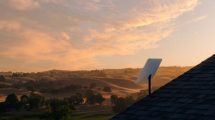 In 2012, Safa Telecom was awarded a contract to implement a remote surveillance system for a construction project in Uganda. A new road was being built in a remote location and workflow, progress and equipment needed to be monitored. Another project of a similar nature was awarded in the beginning of 2013 for an oil and gas pipeline in Iraq.
In 2012, Safa Telecom was awarded a contract to implement a remote surveillance system for a construction project in Uganda. A new road was being built in a remote location and workflow, progress and equipment needed to be monitored. Another project of a similar nature was awarded in the beginning of 2013 for an oil and gas pipeline in Iraq.
“Both began shortly after the contacts were awarded. The Uganda project went live three hours after we finished – it was a very quick turnaround. The Iraq project is scheduled to go live this summer,” says Nabil Ben Soussia, Managing Director, Safa Telecom Abu Dhabi.
“Regarding the road construction in Uganda, the situation was that the client was based in the UAE. The problem was that the workflow was not consistent and every time management went to the site in Uganda, everything seemed to be going well, all workers were going ahead without any problems, and everything seemed fantastic.
“The client, therefore, wanted to remotely monitor the workers, check on how streamlined the processes were and look at how to increase efficiencies. But as the company was constructing this new road, there were no communications, 3G or any way to connect a camera for surveillance.”
Safa Telecom deigned a mobile system involving a car appointed with surveillance equipment so that it could go to site and transmit live the on-going work over a Thuraya network. While the system had limited bandwidth it enabled mobility, which was important for this project. Additionally, the client needed to have access to video conferencing, as video reports often provide better understanding. A crucial aspect was for the monitoring to be as non-invasive as possible, else this project would yield the same results as management going there in person.
“We sent in a car fitted with a vehicular antenna and a Thuraya IP so that it could stop at various points where there was on-going construction and shoot the activities live. This let the management based in the UAE monitor activities and understand the situation. Monitoring had to be done remotely because everyone would know management was watching, and if this happened, all workflows would go along well.”
The surveillance equipment for this project comprised an installed camera, antenna and a briefcase-sized Rapid Deployment Kit (RDK).
“The RDK case just needs to be opened for you to shoot and transmit through an IP to the headquarters of the client company. The RDK case has a camera for video conferencing and an external camera, which can be connected so that various angles or specific activities can be recorded and monitored. Of course, with RDK you can choose which camera to use to transmit footage.
“The latency is around one second, which is not a problem; it even allows dialog. However, regarding such surveillance, latency is not a worry – one second or even five seconds is not an issue.”
This project was purely mobile surveillance, although, Safa Telecom provides a variety of solutions, says Ben Soussia.
“However, transmitting video has required Thuraya or Inmarsat, making these solutions quite costly. Of course, when you consider the costs associated with the construction of a new road, it’s not comparatively big. But the recurrent cost of the link to the satellite is USD 3,500 per month. This is why the client only had one terminal.
“This has been the typical surveillance market, but we have started working with YahSat, which is bringing YahClick, something new, to the market. It will allow us to accommodate a lot of sites as the cost of the link to the satellite is going to be around USD 150 – a massive difference compared to the current USD 3,500.”
The reason for this significant difference in price is due to the L-band being replaced with Ka-band, which allows greater bandwidth, lowering costs. However, this does mean that mobility is lost, says Ben Soussia, adding that YahSat will have a mobile solution by July or August this year.
The project for the oil and gas pipeline in Iraq was similar to the Uganda project in that the client needed to monitor staff and workflow while being based in the UAE. It was decided that for the first phase of the project just three cameras would be used.
“Three may sound small but considering the costs involved, it’s really something that just an oil and gas company can afford. These three cameras cost USD 10,000 per month, which is too great a figure for many other companies.”
YahClick has major implications for the Iraq project, explains Ben Soussia.
“The initial size of the Uganda project was much larger, but this was reduced to one terminal due to the costs involved. However, on the other hand, the size of the Iraq project radically increased. Initially it was three cameras but due to YahClick this will be scaling to 50. With the Ka-band system offered by Yahclick we are able to address the client’s need for numerous terminals while keeping within the budget, something that would not be possible using other systems.
“The communication budget per camera for the Uganda project was USD 40,000. For Iraq it’s USD 1,800. This difference is really big – one year back, USD 40,000 got you one terminal but today, you can have 50 terminals for USD 90,000.”
While surveillance is not a big part of Safa Telecom’s operations, says Ben Soussia, he expects it to increase, especially because YahClick is entering the market.
“As we are an international company, we will be looking to expand across all markets. Part of the reason why remote surveillance is largely under developed within this region is because of the costs involved. With L band, the costs are raised and you can’t realise real projects with multiple sites. But YahClick will dramatically change this.”
According to Ben Soussia, the challenges associated with surveillance in general are quality and availability of bandwidth. But regarding surveillance of remote sites, a challenge is in monitoring people that are not accustomed to or dislike being monitored, and this can lead to some problems arising among the client’s staff and workers.
“Problems can include cables being cut or equipment damage. A simple solution to this, though, is to have a camera shooting another camera when out in remote places. This can be designed in a way so that the cameras can see each other and have motion sensors that will record when activity is detected.”












Add Comment